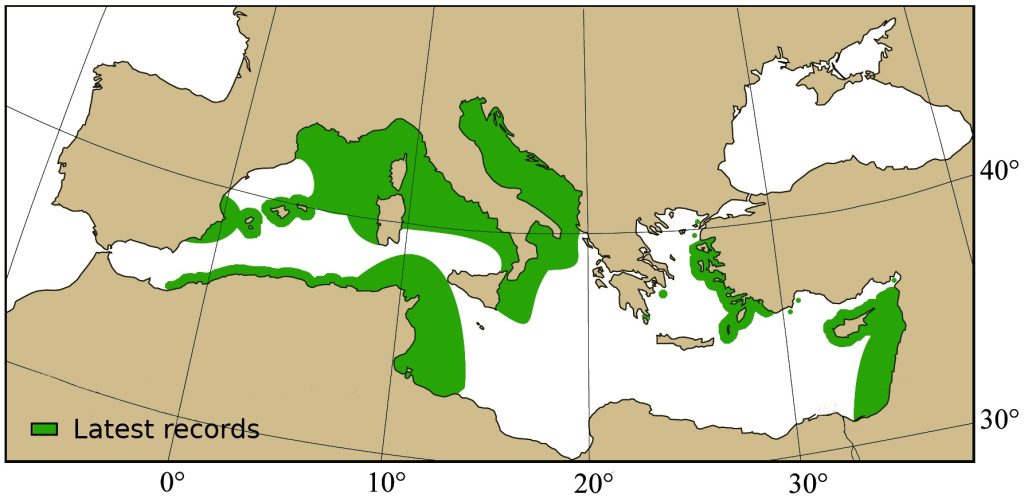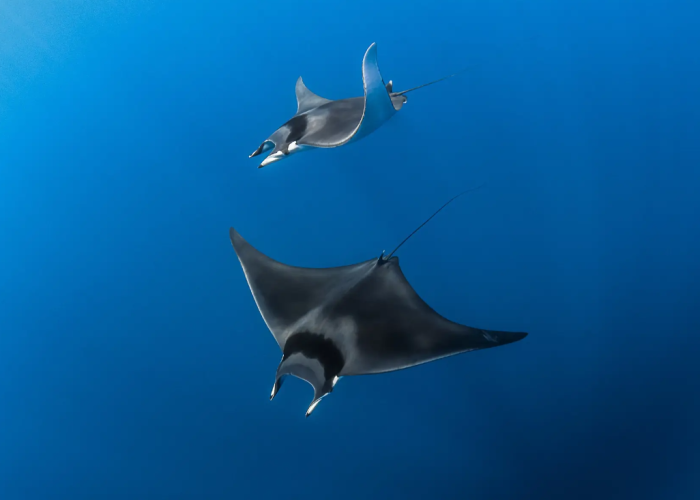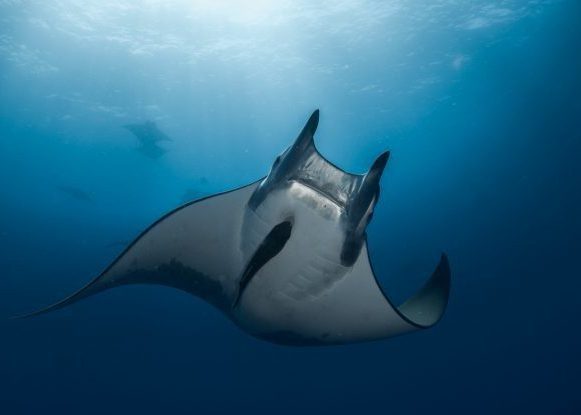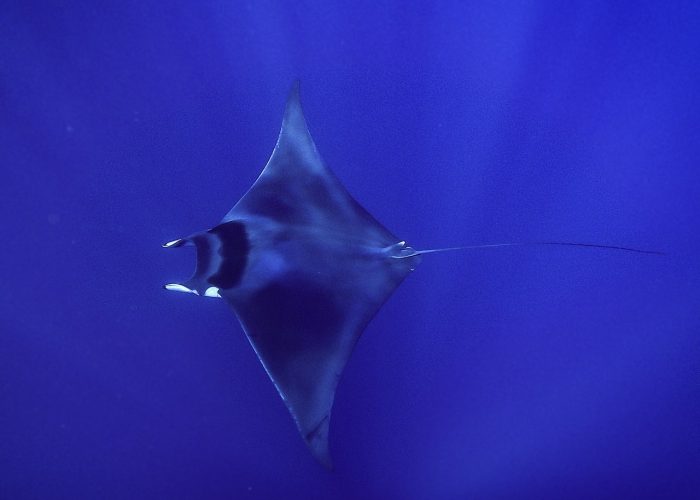Mobula mobular
- Common name : Spinetail Devil Ray, Spinetail Devilray, Giant Devil Ray, Devil Fish
- Order: Myliobatiformes
- Family: Mobulidae
- Synonyms: Cephaloptera giorna, Mobula japanica, Raia mobular
- Misidentifications: Mobula japanica
Short description
Very large species. Long and triangular pectoral fins. Mouth on the ventral side framed by cephalic lobes. Origin of the dorsal fin after the posterior extremity of the pectoral fin. One or more spines and prickles on the tail, behind the dorsal fin. Thin tail, very long, like a whip.
Color: More or less dark blue colour with generally a whitish band around the head. White ventrally.
Measurements:
- Disk width (DW): 300 cm (max 520 cm)
- Total length (TL): up to 650 cm
Swimming pattern: Oscillatory locomotion.
Biology / Ecology
Feeds on small pelagic fishes and crustaceans by funnelling using their cephalic fins and filtering through their specialised gill plates.
Behavior: Generally gregarious.
Reproduction: Viviparous (aplacental viviparity with histotrophy). Size at maturity (DW): 215-240 cm at 5-6 years female and 200-220 cm male. Gestation period: 12 months (probably 20-25 months). Reproductive cycle: 1-3 years. Juveniles per litter: 1 (rarely 2). Size at birth (DW): 90-180 cm.
Habitat: Resides in coastal and continental shelf waters mostly between 0 and 50 m but can reach depths of 600–700 m.
Largest of the sea devils in the world and the only one observed in the Mediterranean.
Distinguishing characteristics
- Cephalic lobe in front of head, like horns.
Myliobatiformes: No caudal and anal fin. Thin tail like a whip.
Mobulidae: Depressed body and rhomboidal disc. Two cephalic lobes on the head.
Distribution
Worldwide: Atlantic from Portugal to South Africa, including the entire Mediterranean. Absent in the Black Sea.
Mediterranean: Patchly distribution in the entire Mediterranean Sea and possibly adjacent Atlantic waters. Possible mating area in the Levantine basin (large winter aggregations). Large-scale movements up to 1 800 km at minimum speeds of 63 km per day, likely driven by seasonal patterns in prey availability.
- Occurrence: Occasional in the western and central Mediterranean. Abundant in the Eastern Mediterranean and in the Adriatic Sea.
- Latest records: Cyprus (2018-2022), Northeastern Aegean Sea (2020), Adriatic Sea (2019), Tunisia (2019), Central and western Mediterranean Sea (2019), Spain (2018), Turkey (2018), Gulf of Antalya (2017), Palestine (2016), Algeria (2006), Syria (2003).

Any recent observation not on the map?
Contact us!
Conservation
Threats: Bycatch in industrial and artisanal fisheries (including trawl, gillnet, set net, tangle net and trammel net). Human consumption (but not considered an economically commercially important species).
Protection level:
- Global: Endangered (IUCN 2020, last assessment: 2018)
Key references
- Abudaya M., Ulman A., Salah J., Fernando D., Wor C., Di Sciara G.N. 2018. Speak of the devil ray (Mobula mobular) fishery in Gaza. Reviews in Fish Biology and Fisheries 28(1): 229-239.
- ACCOBAMS Survey Initiative. 2018. Available online (accessed on 24 August 2022).
- Başusta N., Özbek E.Ö. 2017. New record of giant devil ray, Mobula mobular (Bonnaterre, 1788) from the Gulf of Antalya (Eastern Mediterranean Sea). Journal of the Black Sea/Mediterranean Environment 22: 162-169.
- Carpentieri P., Nastasi A., Sessa M., Srour A. 2021. Incidental catch of vulnerable species in Mediterranean and Black Sea fisheries – A review. General Fisheries Commission for the Mediterranean – Studies and Reviews 101: I-317.
- Giovos I., Serena F., Katsada D., Anastasiadis A., Barash A., Charilaou C., Hall-Spencer J.M.,Crocetta F.,Kaminas A., Kletou D, Maximiadi M., Minasidis V., Moutopoulos D.K., Aga-Spyridopoulou R.N., Thasitis I., Kleitou P. 2021. Integrating literature, biodiversity databases, and citizen-science to reconstruct the checklist of Chondrichthyans in Cyprus (Eastern Mediterranean Sea). Fishes 6(3): 24.
- Kabasakal H., Oruç A., Kalecik E., Sevim E., Araç N., Linç C. İ. 2024. Recent occurences of Rhinoptera marginata and Mobula mobular in Turkish Aegean and Mediterranean waters. Annales: Series Historia Naturalis Vol. 34, No. 1: 51-60.
- Mancusi C., Baino R., Fortuna C., De Sola L.G., Morey G., Bradai M.N., Kallianotis A., Soldo A., Hemida F. Saad A.., Dimech M., Peristeraki P., Bariche M., Clo S., De Sabata E., Castellano L., Garibaldi F., Lanteri L., Tinti F., Pais A., Sperone E., Micarelli P., Poisson F., Sion L., Carlucci R., Cebrian-Menchero D., Seret B., Ferretti F., El-Far A., Saygu I., Shakman E., Bartoli A., Guallart J., Damalas D., Megalofonou P., Vacchi M., Colloca F., Bottaro M., Notarbartolo Di Sciara G., Follesa M.C., Cannas R., Kabasakal H., Zava B., Cavlan G., Jung A., Abudaya M., Kolitari J., Barash A., Joksimovic A., Cetkovic I., Marceta B., Gonzalez Vilas L., Tiralongo F., Giovos I., Bargnesi F., Lelli S., Barone M., Moro S., Mazzoldi C., Abella A., Serena F. 2020. MEDLEM database, a data collection on large Elasmobranchs in the Mediterranean and Black seas. Mediterranean Marine Science 21(2): 276-288.
- O’Keefe M., Bengil EG., Palmer JL, Beton D, Çağlar Ç., Godley B.J, Özkan M., Snape R.T.E., Broderick A.C. 2023. Diversity and distribution of elasmobranchs in the coastal waters of Cyprus: using bycatch data to inform management and conservation. Front. Mar. Sci. 10: 1181437.
- Notarbartolo di Sciara G., Lauriano G., Pierantonio N., Cañadas A., Donovan G., Panigada S. 2015. The devil we don’t know: investigating habitat and abundance of endangered giant devil rays in the North-Western Mediterranean Sea. PLOS ONE 10(11): e0141189.



